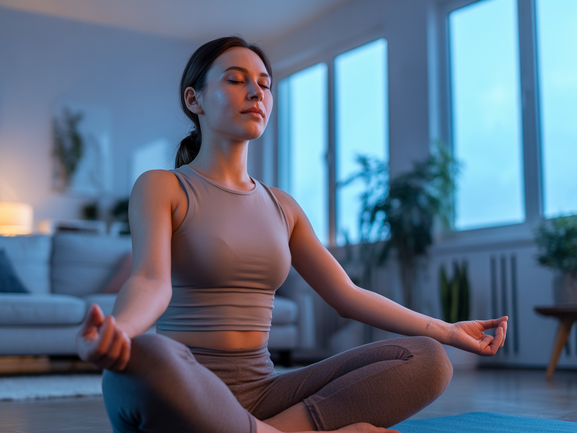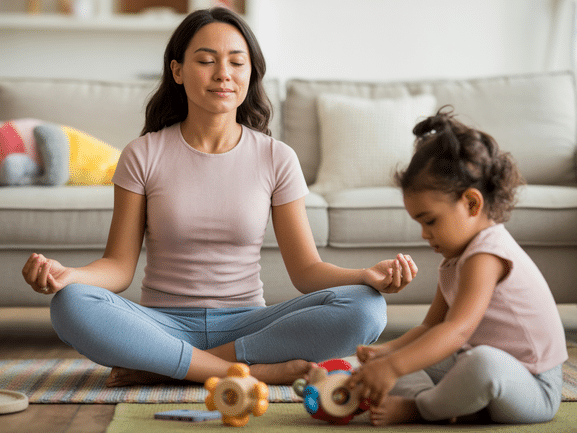Yoga for Anxiety: A Comprehensive Guide to Finding Inner Peace
In a world buzzing with constant stress, finding effective anxiety relief is essential. Yoga, an ancient practice blending mind and body, offers a powerful solution. This guide explores how to use yoga for anxiety, with insights from international teacher Luzia, co-founder of the Vitalizen App | Yoga + Meditation. Her mission is to make authentic, science-backed wellness accessible. This isn’t just about poses; it’s about regulating your nervous system to build lasting mental resilience. If you’re seeking calm in the chaos, you’re in the right place. Let’s explore how yoga for anxiety can transform your life, one breath at a time.

What Is Yoga for Anxiety?
When most people think of yoga, they picture complex physical postures. However, yoga for anxiety is a much deeper, holistic discipline tailored to calm an overactive mind and soothe the body’s stress response. It combines gentle movements (Asanas), controlled breathing (Pranayama), and guided meditation (Dhyana) to restore balance. Unlike a typical workout, the goal of yoga for anxiety is not just physical exertion; it’s about cultivating a state of inner peace and mindful awareness that extends far beyond the mat. This practice empowers you to build a toolkit of techniques to face life’s challenges with greater calm and clarity.
How Does Yoga Scientifically Relieve Anxiety?
The effectiveness of yoga for anxiety is robustly supported by scientific research. The practice directly influences the autonomic nervous system, which regulates our stress response. Anxiety often traps us in a state of high alert, dominated by the sympathetic nervous system (‘fight-or-flight’). Yoga helps activate the parasympathetic nervous system (‘rest-and-digest’), signaling to your body that it is safe to relax.
This activation leads to key physiological changes:
- Cortisol Reduction: Consistent yoga practice has been shown to lower levels of cortisol, the primary stress hormone. High cortisol is linked to chronic anxiety and sleep issues.
- GABA Increase: Certain yoga practices can increase levels of Gamma-aminobutyric acid (GABA) in the brain. GABA is a neurotransmitter with a calming effect, and low levels are associated with anxiety disorders.
- Vagus Nerve Stimulation: Deep, mindful breathing—a core component of yoga for anxiety—stimulates the vagus nerve. This nerve is a primary component of the parasympathetic nervous system and plays a crucial role in slowing heart rate and promoting relaxation.
- Improved Heart Rate Variability (HRV): Mindful breathing improves HRV, a measure of your nervous system’s ability to adapt to stress. Higher HRV indicates better emotional and physical resilience.
According to the National Center for Complementary and Integrative Health (NCCIH), a U.S. government agency, strong evidence suggests yoga is an effective tool for managing stress and improving mental well-being. You can read more on their findings here. Luzia’s method, featured in the Vitalizen App, is built on these principles, combining ancient wisdom with a modern, scientific understanding of the mind-body connection.
5 Beginner-Friendly Yoga Poses for Anxiety Relief
Starting your yoga for anxiety journey is simple. These five gentle poses are perfect for beginners and can be done anywhere. Focus on your breath and move with intention.
1. Marjaryasana-Bitilasana (Cat-Cow Pose)
This gentle, flowing movement connects breath to motion, releasing tension in the spine and calming the mind.
- Start on your hands and knees in a tabletop position.
- Inhale (Cow): Drop your belly, lift your chest and tailbone, and look forward.
- Exhale (Cat): Round your spine, press the mat away, and tuck your chin to your chest.
- Repeat for 10-15 breaths, flowing smoothly between the two poses.
2. Balasana (Child’s Pose)
A deeply restorative pose that gently stretches the back and hips while promoting a sense of safety and calm.
- From tabletop, bring your big toes to touch and knees wide apart.
- Sit back on your heels and fold forward, resting your forehead on the mat.
- Extend your arms forward or rest them alongside your body. Hold for 1-3 minutes.
3. Viparita Karani (Legs-Up-The-Wall Pose)
This passive inversion is incredibly effective for calming the nervous system and reducing fatigue.
- Sit sideways next to a wall.
- Swing your legs up the wall as you lie back on the floor.
- Rest with your arms by your sides, palms up. Stay for 5-15 minutes.
4. Setu Bandhasana (Bridge Pose)
A gentle backbend that opens the chest and heart, counteracting the slouched posture often associated with anxiety.
- Lie on your back with knees bent, feet flat on the floor, hip-width apart.
- Press into your feet to lift your hips off the floor.
- Clasp your hands underneath you and hold for 30-60 seconds.
5. Savasana (Corpse Pose)
The final relaxation pose in most yoga practices. It allows your body to integrate the benefits of the practice and achieve deep rest.
- Lie flat on your back, letting your feet fall open naturally.
- Rest your arms by your sides, palms facing up.
- Close your eyes and focus on your breath for 5-10 minutes. This is a key practice in yoga for anxiety.
3 Powerful Breathing Techniques (Pranayama) for Immediate Calm
Your breath is the most powerful tool for managing anxiety. Here are three simple pranayama techniques from the practice of yoga for anxiety.
- Sama Vritti (Box Breathing): Inhale for a count of 4, hold for 4, exhale for 4, and hold for 4. Repeat for 2-5 minutes.
- 4-7-8 Breathing: Inhale through your nose for 4 counts, hold your breath for 7 counts, and exhale slowly through your mouth for 8 counts. Repeat 3-5 times.
- Diaphragmatic Breathing (Belly Breathing): Place one hand on your chest and the other on your belly. Inhale deeply through your nose, allowing your belly to expand. Exhale slowly, feeling your belly fall. This is a foundational technique for any yoga practice for anxiety.
What Are the Main Benefits of Practicing Yoga for Anxiety?
Committing to a regular yoga for anxiety practice offers a wide range of benefits that enhance both mental and physical health. By practicing with an experienced online yoga teacher like Luzia, you can unlock these transformative results.
- Improved Stress Response: You learn to stay calm and centered, even when faced with stressful situations.
- Better Sleep Quality: The relaxing effects of yoga can help you fall asleep faster and enjoy deeper, more restorative rest.
- Increased Mindfulness: You become more present and aware of your thoughts and feelings without being overwhelmed by them.
- Reduced Physical Tension: Gentle stretches release tension stored in the neck, shoulders, and back.
- Enhanced Emotional Regulation: You develop a greater capacity to manage your emotions, reducing reactivity and mood swings.
These benefits compound over time, leading to a significant improvement in your overall quality of life. Explore our articles, news, tips, and guidance on yoga and meditation for more insights.
How to Start with Yoga for Anxiety Today?
Starting a new practice can feel intimidating, but getting started with yoga for anxiety is easier than you think. The key is a simple, accessible approach. You don’t need to be flexible or have prior experience. The journey begins with a single, conscious breath.
- Find a Reliable Guide: Learning from an experienced teacher is crucial. An expert like Luzia provides the nuanced instruction needed to address anxiety. The Vitalizen App makes her expertise accessible anytime, anywhere.
- Create a Consistent Schedule: Consistency is more important than duration. Start with just 10-15 minutes a day. A regular routine helps build momentum.
- Start with Beginner-Friendly Practices: Focus on gentle flows, simple breathing exercises, and short guided meditations.
- Focus on Your Breath: Your breath is your most powerful tool. Throughout your practice, maintain a slow, deep, and steady breath. This is the anchor that calms your mind.
The Vitalizen yoga app is designed to guide you through these steps. Start your wellness journey now and discover the transformative power of accessible self-care.
Why Is an Expert Guide Like Luzia Crucial?
Luzia’s expertise is not confined to a single tradition. Her travels across Asia, Europe, and the Americas have allowed her to absorb a rich tapestry of techniques for anxiety management. In India, she delved into ancient yogic philosophies. In Europe, she explored modern mindfulness and somatic practices, giving her a scientific understanding of the mind-body interaction. This unique fusion of ancient wisdom and modern science is what makes her approach to yoga for anxiety so effective. Her method is a truly *holistic system* that addresses anxiety from multiple angles.
What Do Real Users Say?
The impact of Luzia’s work is best told through the stories of those she has helped. The results speak for themselves: a calmer mind and a better quality of life.
“I was struggling with constant panic attacks. After just a few weeks of using the Vitalizen App, I learned breathing techniques that helped me manage my anxiety. Luzia’s calming voice is so reassuring.”
– Sarah, 32
“I never thought yoga was for me. But the app made it so easy to start. The short, guided meditations have made a huge difference in my daily stress levels.”
– Mark, 45
These experiences highlight tangible, positive change. The table below shows typical results based on user feedback.
| Metric | Before Vitalizen | After 4 Weeks |
|---|---|---|
| Self-Reported Anxiety (1-10) | 8.5 | 4.0 |
| Sleep Quality (1-10) | 3.5 | 7.5 |
💡 Ready to Find Your Calm?
Join thousands who have found relief with yoga for anxiety. Download the Vitalizen App and start your free trial today. Your journey to a more peaceful life begins now.
Frequently Asked Questions About Yoga for Anxiety
How does yoga specifically help with anxiety?
Yoga for anxiety works by activating the ‘rest and digest’ nervous system. Practices like deep breathing and specific poses lower heart rate, reduce the stress hormone cortisol, and increase GABA, a calming neurotransmitter. This leads to both immediate and long-term anxiety relief.
Why is an experienced teacher important for anxiety?
An experienced teacher like Luzia provides safe, effective, and tailored guidance. They offer nuanced instruction on alignment and breathing, which is crucial for maximizing benefits and creating a supportive environment when dealing with anxiety.
How long does it take to see results from using yoga for anxiety?
Many users report an immediate sense of calm after their first session. For lasting change in anxiety levels, consistency is key. With regular practice (3-4 times a week), most people notice significant improvements in mood, sleep, and well-being within 2 to 4 weeks.
For any other questions, feel free to contact us. For further reading from an authoritative source, see this article on Yoga for Anxiety and Depression from the Journal of Medical Internet Research.


